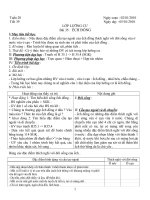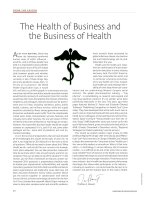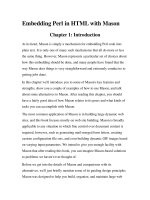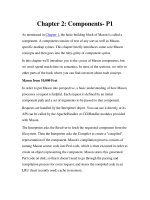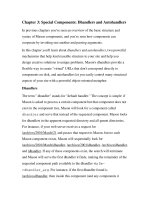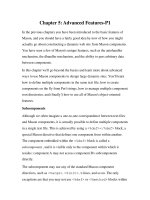Tài liệu MATERNAL HEALTH IN NIGERIA WITH LEADERSHIP, PROGRESS IS POSSIBLE potx
Bạn đang xem bản rút gọn của tài liệu. Xem và tải ngay bản đầy đủ của tài liệu tại đây (2.22 MB, 22 trang )
a report of the csis
global health policy center
Jennifer G. Cooke
Farha Tahir
Authors
January 2013
Maternal Health in Nigeria
with leadership, progress is possible
CHARTING
our future
Blank
January 2013
a report of the csis
global health policy center
Maternal Health in Nigeria
with leadership, progress is possible
Authors
Jennifer G. Cooke
Farha Tahir
About CSIS—50th Anniversary Year
For 50 years, the Center for Strategic and International Studies (CSIS) has developed solutions to the
world’s greatest policy challenges. As we celebrate this milestone, CSIS scholars are developing
strategic insights and bipartisan policy solutions to help decisionmakers chart a course toward a
better world.
CSIS is a nonprofit organization headquartered in Washington, D.C. The Center’s 220 full-time staff
and large network of affiliated scholars conduct research and analysis and develop policy initiatives
that look into the future and anticipate change.
Founded at the height of the Cold War by David M. Abshire and Admiral Arleigh Burke, CSIS was
dedicated to finding ways to sustain American prominence and prosperity as a force for good in the
world. Since 1962, CSIS has become one of the world’s preeminent international institutions focused
on defense and security; regional stability; and transnational challenges ranging from energy and
climate to global health and economic integration.
Former U.S. senator Sam Nunn has chaired the CSIS Board of Trustees since 1999. Former deputy
secretary of defense John J. Hamre became the Center’s president and chief executive officer in April
2000.
CSIS does not take specific policy positions; accordingly, all views expressed herein should be
understood to be solely those of the author(s).
© 2013 by the Center for Strategic and International Studies. All rights reserved.
Cover photo: Hauwa’u, 25, mother from Rogogo community, Katsina; photo by Lindsay Mgbor/DFID;
Center for Strategic and International Studies
1800 K Street, NW, Washington, DC 20006
Tel: (202) 887-0200
Fax: (202) 775-3199
Web: www.csis.org
| 1
embedd
Jennifer G. Cooke and Farha Tahir
1
Introduction
As the Millennium Development Goals (MDGs) target date of 2015 approaches, there is a growing
sense of urgency among international agencies to intensify efforts on the global challenge of maternal
health, where, according to the 2012 MDG progress report, levels of maternal mortality remain “far
from the 2015 target.”
2
In 2012, both the G-8 and the African Union made maternal and child health
a keystone of their respective annual summits, and the United Nations launched the Global Strategy
for Women’s and Children’s Health at a special General Assembly event. A 2012 global summit in
London, co-led by the Gates Foundation, the UK government, and the UN Population Fund,
generated $2.6 billion in donor pledges for family planning, a critical element of maternal health. The
United States has made maternal health an increasingly important element in U.S. global health
efforts, manifested most recently with the launch in June 2012 of the Saving Mothers, Giving Life
initiative. The initiative, an ambitious public-private partnership intended “to drive efficiencies, spur
innovation, and ensure impact” in maternal health,
3
has the strong backing of Secretary of State
Hillary Clinton, for whom maternal and child health, and women’s empowerment more generally,
have been consistent priorities.
In achieving the MDG target of reducing global maternal mortality by 75 percent, progress in Nigeria
could prove pivotal. In 2010, an estimated 40,000 Nigerian women died in childbirth. The country
accounts for an estimated 14 percent of maternal deaths worldwide.
4
Nigeria remains 1 of the 10
1
Jennifer G. Cooke is director of the Africa Program at the Center for Strategic and International Studies
(CSIS) in Washington, D.C. Farha Tahir is program coordinator and research associate with the CSIS Africa
Program.
2
UN Inter-Agency and Expert Group on MDG Indicators, The Millennium Development Goals Report: 2012
(New York: United Nations, 2012), p. 5,
english/The_MDG_Report_2012.pdf.
3
Janet Fleischman, “Saving Mothers, Giving Life: Attainable or Simply Aspirational?” Center for Strategic and
International Studies, June 2012, p. 1,
JFleischman.pdf.
4
WHO, UNICEF, UNFPA, and World Bank, Trends in Maternal Mortality: 1990–2010 (Geneva: World Health
Organization, 2012), p. 22,
publications/2012/Trends_in_maternal_mortality_A4-1.pdf.
maternal health in nigeria
with leadership, progress is
possible
2 | maternal health in nigeria
most dangerous countries in the world for a woman to give birth: it is estimated that 630 of every
100,000 live births result in a maternal death.
5
But despite bleak national statistics, there are some signs of growing opportunity in Nigeria. In the
last five years, the federal government has devoted far greater policy attention and resources to
maternal health than previously, and a handful of state governments are beginning to tackle the
challenge in a strategic and comprehensive way.
In August 2012, CSIS Africa Program staff traveled to Nigeria to conduct a series of interviews with
government officials, implementing agencies, and health professionals to better understand the
country’s national strategy on maternal health and the obstacles that are slowing progress. The aim
was to get a sense of challenges at the state and local government level, to determine where
responsibility lies for primary health care, and to identify instances where real progress is being
made.
In that vein, the CSIS team visited Ondo State, in the South West region of Nigeria, where the
government’s “Abiye” (“Safe Motherhood” in the Yoruba language) initiative has won early praise
from maternal and public health experts in Nigeria and beyond. The program is seen by many as a
promising, “home-grown” effort to build a comprehensive, sustainable, and evidence-driven
approach that ensures that women have reliable access to quality maternal health services. The Ondo
approach is not dramatically new; rather, it is an example of how broad principles of maternal
health—on which there has been widespread agreement for several decades—can be tailored to
localized circumstances and implemented in a concerted, organized way.
The Ondo State Abiye program is a work in progress, and the initiative’s leadership is cognizant of
the challenges associated with scale-up and sustainability over time. But the program does provide a
positive preliminary model of how data collection, technology and innovation, efficient use of
resources, and mechanisms of accountability—backed by sustained political will—can come together
in a comprehensive strategy that, in its first two years, is yielding significant results.
Why is this important? Much of the global literature and policy attention on maternal health has
focused on the barriers to improved outcomes. Likewise, donor resources have understandably been
directed largely to countries and regions where progress has been slowest. Nonetheless, to generate
and sustain momentum on maternal health it will be equally important to identify and support
instances where concrete progress is being made. Successful models can serve as an encouragement
to policymakers and health implementers elsewhere and can offer practical examples of what is
possible with local innovation, leadership, and planning. Perhaps most important is to create an
expectation among citizens, communities, and civil society that in turn strengthens constituencies for
maternal health and more broadly for service delivery and governance.
5
Ibid.
jennifer g. cooke and farha tahir |
3
The purpose of this report is to highlight one such effort, which warrants encouragement and bears
watching as Nigeria, the United States, and the broader global community seek more effective and
innovative approaches to the challenge of maternal mortality.
A Maternal Health Snapshot of Nigeria
Nigeria has made progress in the last two decades in reducing maternal deaths, but the number of
women who die in pregnancy or from complications associated with child-birth remains appallingly
high. Nigeria is Africa’s most populous country and, despite being one of its wealthiest, continues to
experience high rates of maternal deaths. The country has the 10th-highest maternal mortality ratio
(MMR) in the world, according to UN estimates, with 630 women dying per 100,000 births—a
higher proportion than in Afghanistan or Haiti, and only slightly lower than in Liberia or Sudan.
6
An
estimated 40,000 Nigerian women die in pregnancy or childbirth each year,
7
and another 1 million to
1.6 million suffer from serious disabilities from pregnancy- and birth-related causes annually.
8
Nigerian women have an average total of 5.7 births in their life, with each pregnancy exposing them
to the risk of maternal complications. Over her lifetime, a Nigerian woman’s risk of dying from
pregnancy or childbirth is 1 in 29, compared to the sub-Saharan average of 1 in 39 and the global
average of 1 in 180. In developed regions of the world, a woman’s risk of maternal death is 1 in
3,800.
9
The Millennium Development Goal on improving maternal health calls first for a 75 percent
reduction by 2015 in the maternal mortality rate from 1990 levels— for Nigeria (using estimates from
the country’s 2008 Demographic and Health Survey, which are slightly lower than UN estimates), a
reduction to 250 maternal deaths per 100,000 live births; and second, for 100 percent of deliveries to
be assisted by a skilled birth attendant. It is possible, according to the Nigerian government’s 2010
estimation, that the country can reach the maternal mortality target by 2015, but this will require
dramatic and sustained progress in the next three years.
10
On deliveries attended by skilled birth
6
Ibid., p. 23. The MMR of 630 is with a range of uncertainty between 370 and 1,200. Nigeria’s national 2008
Demographic and Health Survey estimates the country’s MMR at 545 per 100,000 live births. National
Population Commission (NPC) [Nigeria] and ICF Macro, Nigeria Demographic and Health Survey 2008
(Abuja: National Population Commission and ICF Macro, 2009), p. 8,
pdf/SR173/SR173.pdf.
7
WHO, UNICEF, UNFPA, and World Bank, Trends in Maternal Mortality: 1990–2010, p. 22.
8
USAID Nigeria, “Maternal and Child Health Integrated Program (MCHIP),” USAID Nigeria, 2012,
/>intergrated-program-mchi.
9
World Health Organization, “Maternal Mortality,” Fact sheet no. 348, WHO Media Centre, May 2012,
10
National Planning Commission (NPC) and the Office of the Senior Special Assistant to the President on
MDGs (OSSAPMDGs), Nigeria Millennium Development Goals: Report 2010 (Abuja: Government of the
Federal Republic of Nigeria, 2010), p. 31.
4 | maternal health in nigeria
attendants, Nigeria has regressed: in 2008, the proportion of attended births was actually lower, at
38.9 percent, than the 1990 level of 45 percent.
11
Within Nigeria, there are significant disparities among regions, and Northern Nigeria has far higher
maternal mortality rates than the wealthier South. The extremely poor North East has an estimated
maternal mortality rate of 1,549, more than five times the global average.
12
Poverty, a lack of
investment in health systems, low educational levels, and infrastructure have each contributed to the
disparity; cultural factors that give women limited mobility and contact with the formal health care
system and little say in household and personal decisionmaking also contribute—measures of
women’s empowerment are consistently lower than in most of Nigeria’s southern states. There have
been instances of leadership on maternal health in the North (Kano State was the first in Nigeria to
introduce free maternal care in 2003), but they have not always been sustained. Today, terror attacks
by the extremist group Boko Haram have forced many health and development implementers to shut
down or scale back operations in the North, and public health experts fear that prolonged insecurity
will very likely reverse or eliminate the gains of the last decade.
The Barriers to Maternal Health
The great and tragic irony of maternal mortality—in Nigeria and elsewhere in the developing
world—is that the vast majority of maternal deaths are avoidable through relatively uncomplicated
health interventions.
13
But ensuring that women have access to, and seek out, these basic health
services has proved a complex and daunting task. The barriers to access are multiple, ranging from a
woman’s immediate economic circumstances and cultural context to the weakness and limited reach
of the country’s primary health system to the financing, capacity, and political will that governments
devote to the issue. Maternal health in Nigeria is a powerful barometer of broader trends in
development, in health and health capacity, and ultimately in governance and investment on behalf
of society’s least powerful citizens.
The immediate causes of maternal mortality in Nigeria parallel those in much of the developing
world: postpartum hemorrhage accounts for an estimated 23 percent of maternal deaths; sepsis for
17 percent; and eclampsia, unsafe abortion, obstructed labor, and anemia for 11 percent each.
14
(See
text box.) In conversations with health officials, postpartum hemorrhage and eclampsia were most
11
Ibid.
12
Seye Abimbola et al., “The Midwives Service Scheme in Nigeria,” PLoS Med 9, no. 5 (May 2012),
13
Phillip Nieburg, Improving Maternal Mortality and Other Aspects of Women’s Health: The United States’
Global Role (Washington, D.C.: CSIS, October 2012), pp. 10–11,
121003_Nieburg_MaternalMortality_Web.pdf.
14
Nigeria Federal Ministry of Health, National Strategic Health Development Plan (NSHDP) 2010–2015 (Abuja:
Federal Ministry of Health, 2010), p. 28, linkservid/31BA7388-
1CC0-70AB-CBB76E498625E6CF/showMeta/0/.
jennifer g. cooke and farha tahir |
5
Leading Causes of Maternal Mortality in Nigeria
Hemorrhage: Maternal hemorrhage is severe bleeding that occurs most frequently postpartum. Most
women exhibit no signs of risk before the bleeding begins,
1
but death from hypovolemic shock can
occur quickly if unattended, with severe cases occurring within two hours of onset of bleeding.
2
A set of
basic clinical procedures can prevent and/or effectively treat postpartum hemorrhage, and in the
absence of a skilled attendant, an oral dose of misoprostol or an oxytocin injection can prevent
excessive bleeding.
3
The non-pneumatic anti-shock garment, recently introduced in Nigeria, is a low-
tech device that can be used to reverse or prevent shock by maintaining blood flow to the heart, lungs,
and brain, buying time for a skilled attendant’s arrival. These methods are particularly important in rural
settings, where distance often precludes prompt treatment.
Sepsis: Maternal sepsis is infection of the genital tract occurring any time between the onset of labor
and six weeks postpartum. Contributing factors are home birth in unhygienic conditions, poor nutrition,
unsafe abortion and caesarian section. Labor management and training of traditional birth attendants
are effective in preventing sepsis, and antibiotics are the principal mode of treatment.
4
Preeclampsia/Eclampsia: Preeclampsia (also known as toxemia) is the rapid elevation of blood pressure
during pregnancy. If untreated, it can lead to seizures (eclampsia), kidney and liver damage, and
ultimately, death of the mother and/or the fetus. Injectable magnesium sulfate is considered an
effective and low-cost intervention for treating eclampsia. Preeclampsia can often be diagnosed if the
pregnant woman exhibits edema (swelling).
________________
1. Barbara Shane, “Preventing Postpartum Hemorrhage: Managing the Third Stage of Labor,” PATH Outlook 19, no. 3
(September 2001), p. 3,
2. World Health Organization, World Health Report 2005: Make every mother and child count (Geneva: World Health
Organization, 2005), p. 63.
3. Family Care International Inc. & Gynuity Health Projects, Postpartum Hemorrhage: A challenge for safe motherhood (New
York: Family Care International Inc. & Gynuity Health Projects, 2006).
4. Kaiser Family Foundation, “Global Health Interventions: A Review of the Evidence: Maternal Sepsis,” 2012,
frequently cited as the primary causes, according to a senior health authority in Ondo State,
accounting for an estimated 75 percent of complications, although they repeatedly emphasized the
need for more reliable, hard data. These complications can be difficult to predict in any particular
individual, but a woman’s risk of dying from these causes falls dramatically if she seeks, and has
access to, effective antenatal care and if she delivers her baby in the presence of a skilled birth
attendant.
15
Many factors impede a woman from seeking care. Almost three-quarters of Nigerian women have at
least one problem accessing care, with concern over costs, drug availability, and distance to a health
facility most often cited. (See table.) Nigeria’s 2008 Demographic and Health Survey (DHS)
15
UN Population Fund, “Skilled Attendance at Birth,” UNFPA, 2012,
mothers/pid/4383. According to UNICEF, a “skilled attendant” is someone with midwifery skills (for example,
doctors, midwives, and nurses) who has been trained to proficiency in the skills necessary to manage normal
deliveries and diagnose, manage, or refer obstetric complications.
6 | maternal health in nigeria
reveals that a woman’s likelihood of seeking
antenatal care and delivering her baby with
a skilled birth attendant present is closely
correlated with residence (urban or rural),
level of education, wealth, and level of
empowerment within her household. A
woman with a primary school education, for
example, is almost 10 times more likely than
a woman with no education to seek at least
one antenatal care visit and four times more
likely to deliver her baby in a health facility.
According to the DHS, one-third of
Nigerian women with no education will
deliver their babies completely alone.
Maternal health is highly contingent on the
quality of the local primary health care
system, which is a common entry point for antenatal care that helps identify problems in pregnancy
early on. Consistently poor performance in primary health facilities—including lack of personnel,
lack of appropriate medicines, and indifferent or contemptuous treatment by facility staff—not only
undermines the quality of care an expectant mother receives, but over time erodes confidence in the
health care system overall and deters women from seeking care. When complications arise, access to
emergency medical care is critical, and survival will often hinge on the speed of diagnosis, referral,
and transportation to secondary facilities and more skilled care. Linkages between the various levels
of health care are therefore essential.
In Nigeria’s tiered federal structure, primary health care is the responsibility of the country’s 774
local government authorities (LGAs), long considered the weakest link in Nigeria’s vast and often
dysfunctional governance system. LGAs are mandated to finance and administer primary health
care, aided, in theory, by the National Primary Health Care Development Agency (NPHCDA), a
federal parastatal responsible for the development and enforcement of guidelines on primary health
implementation. But LGA chairs, although locally elected, are often answerable or beholden to state
governors. And resources directed to LGAs, although nominally independent, have often proved
vulnerable to diversion or delay because of corruption or other spending priorities at the state level.
Within this system, incentives for LGAs skew heavily toward political allegiance to the state
governor, rather than to quality of service delivery, community outreach, or response to constituent
demands.
Public health experts interviewed by the CSIS team painted an almost universally bleak picture of
LGAs’ role in health service delivery. It may seem logical on paper, according to one health planner
in Abuja, “but LGAs have no capacity, little finance, and no autonomy. Primary health budgets go
Reported Problems Accessing Health
Care, Women 20-34 (%)
At least one problem accessing care
73
Getting money for treatment
56.4
Concern no drugs available
41.4
Distance to health facility
35.3
Having to take transport
33.1
Concerned no provider available
33.5
Concerned no female provider available
20.3
Not wanting to go alone
15.7
Getting permission to go for treatment
13.3
Source: DHS 2008.
jennifer g. cooke and farha tahir |
7
through the state government, and LGAs take what they get. The result [at the primary health level]is
no drugs, no commodities, inadequate staff, and facilities that are not being used.”
16
“Maternal and
child health,” said another Abuja-based health professional, “is the single best indicator of the state of
governance.” A consistent refrain throughout the CSIS visit was that without political will, without
effective mechanisms of accountability and feedback across the three tiers of government, and
without incentives for performance and delivery to communities in need, Nigeria will be slow to
make progress on maternal health.
Signs of Momentum at the Federal Level
Despite general frustration with Nigeria’s maternal health indicators, a number of public health
experts interviewed by the CSIS team pointed to incipient developments that offer hope of more
rapid progress. The findings of the 2008 DHS, which underscored the slow pace of change, were
described variously as “scandalous” and “embarrassing.” The DHS, combined with the approach of
the MDG deadline, has helped galvanize greater action by the federal authorities, who are rankled by
a national MMR well above the regional average and concerned with Nigeria’s reputation as a
continental leader.
The federal government has over the years signed on to a host of international declarations on
reproductive health, and maternal health has featured as a prominent element in successive
governments’ national health pledges and strategies. Some of these commitments and initiatives have
proved more aspirational than operational. A National Health Bill, which among other things
delineates more clearly the roles and responsibilities of federal, state, and local government and
directs 2 percent of Nigeria’s considerable oil revenues to primary health care, languished in the
National Assembly for seven years. Finally passed by the legislature in May 2011,
17
it was sent back
by the office of the president, which faced concerted resistance by the Nigerian Medical Association
and other health professional associations. A revised bill was introduced in October 2012 but has not
yet been fully passed. A National Health Insurance Scheme has begun to make inroads in the formal
sector but has failed to reach a critical mass; and community health schemes to reach the vast
majority of Nigerians outside the formal sector are not yet working.
Other developments are more promising and have been spurred on by energetic leadership in the
Ministry of Health and by civil society groups—such as the Society of Gynecologists and
Obstetricians of Nigeria (SOGON), the Partnership for Safe Motherhood, and the National Council
of Women’s Societies
18
—that have gained greater influence and support with the demise of military
rule.
16
CSIS interview in Abuja, July 30, 2012.
17
“Hope for Health in Nigeria,” The Lancet 377, issue 9781 (June 4, 2011): 1891,
journals/lancet/ article/PIIS0140-6736%2811%2960791-5/fulltext.
18
J. Shiffman and F.E. Okonofua, “The state of political priority for safe motherhood in Nigeria,” BJOG 114
(2007): 127–133,
8 | maternal health in nigeria
In 2004, with concerted civil society lobbying of the National Assembly, the Ministry of Health was
able to secure for the first time a budget line for reproductive health, with specific funding for safe
motherhood.
19
In 2006, when Nigeria negotiated elimination of $18 billion in national debt, $53
million of the federal Debt Relief Fund was directed to building primary health infrastructure and
strengthening training and procurement for maternal and child health.
20
The last five years have seen an acceleration of these efforts, with an emphasis on building capacity
among states and LGAs on maternal health.
The National Primary Health Care Development Agency in 2009 launched the Midwives Services
Scheme (MSS), funded through the Debt Relief Fund, to ensure higher quality care at primary health
clinics, particularly rural facilities in underserved LGAs. Intended as a partnership among the three
tiers of government, the MSS initiative deploys newly qualified, unemployed, and retired midwives to
rural communities for one-year stints. Midwives are posted to selected primary care facilities that
have the capacity to provide basic essential obstetric care, “clustered” around secondary care facilities
that can provide emergency obstetric care. Salaries are paid by the federal government, supplemented
by an additional stipend from state governments and accommodation provided by LGAs.
21
To date,
4,000 midwives have been deployed to 1,000 primary health care centers. Retention of midwives has
been problematic, as a number of state and local governments have failed to uphold their
commitments of complementary support. Nigerian officials concede that progress has been variable,
but Minister of State for Health Muhammad Pate points to an average reduction in maternal deaths
in targeted facilities of 26 percent since the program’s inception.
22
The Subsidy Reinvestment and Empowerment Program (SURE-P) account, established with monies
accrued through the partial removal of public fuel subsidies in January 2012,
23
has given an added
boost to maternal health efforts. The federal government is setting aside 15 billion Naira
(approximately $95 million) of SURE-P funds for maternal and child health.
24
Funds are intended to
support an ambitious expansion of the MSS program that will add 500 health facilities to the 1,000
already covered by MSS and eventually deploy 2,000 more midwives, 2,000 community health
officers, 6,000 community association workers, and 9,000 village health workers. Pending results of
19
CSIS interview in Abuja, July 30, 2012; and Shiffman and Okonofua, “The state of political priority for safe
motherhood in Nigeria,” p. 129.
20
WHO, “The Nigerian Health System,”
21
Chukwuma Muanya, “SURE-P, NPHCDA mobilise more midwives, CHEWs to reduce maternal, child
deaths,” The Guardian Nigeria, September 13, 2012,
index.php?option=com_content&view=article&id=98490:sure-p-nphcda-mobilise-more-midwives-chews-to-
reduce-maternal-child-deaths&catid=93:science&Itemid=608.
22
Abimbola et al., “The Midwives Service Scheme in Nigeria.”
23
Judd-Leonard Okafor, “Nigeria: Expanded MSS Targets 3 Million Women, 19,000 Jobs,” The Daily Trust,
April 5, 2012.
24
Isi Esene, “FG promises expectant mothers N5,000 stipend,” YNaija!, July 23, 2012,
fg-promises-expectant-mothers-n5000-stipend/.
jennifer g. cooke and farha tahir |
9
an ongoing pilot program in Abuja, the MSS program will also support a conditional cash transfer of
5,000 Naira (approximately $32) to women who seek antenatal care, deliver their baby in a health
facility, and immunize their child.
25
At the July 2012 London Summit on Family Planning, a high-profile international conference of key
donors and partners, the Nigerian delegation announced a government commitment to increase
spending for reproductive health commodities from $3 million annually to $11.35 million annually
for four years, an almost 300 percent increase.
26
Just one week later, the National Council on Health
approved a policy of task-shifting that would allow community health extension workers (CHEWs)
to provide injectable contraceptives outside of health facilities, a move that had faced considerable
resistance among some higher-skill cadres of health professionals. The recommendation, which also
encourages state ministries of health to scale up the practice, is considered a major breakthrough in
expanding access to reproductive services, particularly in those areas where skilled professionals are
scarce.
27
President Jonathan was selected as cochair of the UN Commission on Life-Saving
Commodities for Women and has publicly expressed his strong commitment to both family
planning and maternal health. In May 2011, the government began distributing family planning
commodities to state governments at no cost, with the expectation that they would be distributed to
LGAs and health facilities free of charge.
These initiatives, along with consistent, high-level, public pronouncements on maternal health, have
generated a sense of momentum and opportunity, although many long-time observers are reserving
judgment until implementation and follow-through has begun. The major challenge will be whether
powerful state governors, working with local government authorities, will capitalize on that
momentum and give greater political priority to a segment of the Nigerian citizenry—low-income
women—that is among society’s least powerful.
Building a Strategic Approach at State Level: Ondo
State’s Abiye Program
The Abiye program in Ondo State has won praise from Nigerian and international public health
experts and is gaining prominence within Nigeria as a promising “home-grown” effort to improve
maternal health outcomes. Oby Ezekwesili, then vice president for Africa at the World Bank, praised
the program as “a role model and a benchmark for the African continent in tackling [the] infant and
25
Muanya, “SURE-P, NPHCDA mobilise more midwives, CHEWs to reduce maternal, child deaths.”
26
Dr. Muhammad Ali Pate, minister of state for Federal Republic of Nigeria (address at London Summit on
Family Planning, July 11, 2012).
27
FHI 360, “Nigeria Changes Policy to Expand Community Access to Injectable Contraception,” Works in
PROGRESS 6 (August 2012),
progress_6.htm.
10 | maternal health in nigeria
maternal mortality rate.”
28
“Everybody knows what you need to do to improve maternal health,” said
one observer in Abuja, “but the Ondo government is actually doing it.”
29
Much of the initiative’s success is attributed to Governor Olusegun Mimiko, a medical doctor who
twice served as Ondo State health commissioner. Alarmed by the 2008 DHS findings, which showed
Ondo State as the worst performer on maternal health in the South West region, the governor made
bringing down the state’s maternal mortality rate a top priority. In office since 2009, he has invested
considerable resources and political capital in implementation of the Abiye model, underscored by
the weight he gave the program in his 2012 reelection campaign. According to colleagues in the state
Health Ministry and at the flagship hospital in the state capital Akure, Governor Mimiko has
remained intimately involved in management and oversight of the program and vested in its success.
The Abiye program was launched in 2009. The model was planned as a comprehensive strategy to
address four critical delays that contribute to maternal mortality and morbidity: the delay in deciding
to seek care (because of lack of education about care, mistrust of the health system, family
constraints); the delay in reaching care (because of distance, infrastructure, communication); the
delay in receiving appropriate care on arrival (because of inadequate manpower, supplies, drugs,
health infrastructure); and the delay in referral (when complications beyond local facility capacities
arise). Underpinning the program has been consistent emphasis on data collection and evidence-
based policy, on incentives and accountability, and on the search for efficiencies to ensure
sustainability. These principles emerged as recurrent themes in interviews with state and local health
planners, administrators, and implementers within facilities visited.
The Abiye initiative began with four months of extensive baseline surveys at the community level to
adapt the approach to local circumstances that prevent women from accessing care and the
challenges that LGAs and health clinics face in delivering care. The surveys highlighted the deep
disparities between urban and peripheral areas and the generally low uptake of antenatal services. A
particularly alarming finding was that even among women who sought out antenatal care, only 16
percent ultimately delivered their babies in a health facility.
An initial pilot was launched in the Ifedore LGA, just outside of Akure, and expansion to the state’s
additional 17 LGAs is now underway at an estimated cost of $13 million to $22 million over the next
three to four years. A flagship Mother and Child Hospital in Akure was completed in 2010, and a
second is under construction in the city of Ondo. Two additional facilities have been approved for
construction in Ikare-Akoko and Okitipupa and are projected to be completed in 2015.
The results in the 30 months since the program’s inception have been impressive. Prior to the Abiye
program, Ifedore health facilities managed approximately 100 deliveries annually. In Abiye’s first full
year, more than 2,000 women delivered in health facilities and in the second year more than 6,000,
28
Sola Ogundipe, “World Bank seeks adoption of Ondo State’s Abiye project as model for Africa,” Vanguard
(Nigeria), July 19, 2011, />state%e2%80%99s-Abiye-project-as-model-for-africa/.
29
CSIS interview in Abuja, July 30, 2012.
jennifer g. cooke and farha tahir |
11
according to local health officials. Prior to Abiye, only 16 percent of women who registered for
antenatal care in Ifedore eventually delivered in a health facility; in the program’s second year, the
proportion was over 60 percent. The Akure Mother and Child Hospital in its first 30 months has
registered 50,000 patients, managed 13,000 deliveries, and performed 2,000 caesarian sections—all
free of charge. The program remains a work in progress and will certainly face challenges as it
expands statewide. But its initial success has generated a sense of energy and possibility around
improved maternal health that may help sustain the scale up.
Delay in Seeking Care
To address the delay in seeking care, the model relies heavily on mobile telephones and a subset of
community health extension workers, dubbed “health rangers” in the Abiye program to emphasize
their role as mobile intermediaries between women, communities, and health facilities. When a
woman first registers for antenatal care, in addition to receiving a routine examination and blood
tests, she is assigned to a health ranger for the duration of her pregnancy and receives a starter pack
that includes an antimalarial bed net and a pre-paid mobile phone linking her to her health ranger,
the local health facility, emergency transport, state health authorities, and occasionally, the governor
himself. Health rangers (who also receive pre-paid phones) are assigned 20 to 25 women each and
are expected to make at least four home visits in the course of an individual pregnancy and to follow
up after delivery. They are provided with a customized checklist and are trained to identify signs of
high-risk pregnancy, map out a birth plan and a “complications preparedness” plan, and offer basic
information on nutrition, family planning, child immunizations, and the use of insecticide-treated
mosquito nets to prevent malaria in the mother and eventually the newborn. An important objective
is for health rangers to develop a personal rapport that ultimately builds greater trust in the health
system, to improve tracking of women throughout pregnancy, and to encourage and facilitate
delivery in a health facility.
Delay in Reaching Care
To address the delay in reaching care, health rangers were initially equipped with motorbikes to get
out to communities and to bring women to the primary health facility for registration, antenatal care
visits, and delivery. Since these were eventually deemed impractical in transporting women if they
are in labor or experiencing complications, they have been replaced with low-tech tricycle
ambulances, locally manufactured in Ondo. One health ranger interviewed in Ifedore had
accompanied at least 10 women in the past year to the local health facility via tricycle, although, she
acknowledged, she had to get her husband to do the actual driving. Small ambulance boats are
planned as the program expands to Ondo’s riverine areas. There is some concern regarding the cost
of the tricycle scheme as the program expands, and moving toward pooled community-based
transport services may ultimately be more practical and cost-efficient.
Delay in Receiving Quality Care
To address the delay in receiving quality care, the government’s focus is on constructing or
refurbishing existing facilities in each of Ondo State’s 18 LGAs, hiring additional midwives, and
12 | maternal health in nigeria
training health personnel. With statewide expansion, each LGA will have seven fully functional and
equipped basic health facilities, including two comprehensive health centers and one general
hospital.
Because of a general shortage of health professionals, the Abiye program has placed strong emphasis
on training and on “task-shifting” (or “task-sharing”), which allows lower cadres of health workers to
take on greater responsibilities, freeing up higher cadres for those functions where they are most
critically needed. A first step was to train and optimize use of existing but underutilized community
health extension workers and health rangers. Within health facilities, attendants have been trained to
take over some nursing duties, and nurses in the Akure Hospital have been empowered to handle
some 80 percent of deliveries, including breach and instrumental deliveries, freeing doctors for the 20
percent that come with complications or that require surgery. Task-shifting and ensuring uniform
quality of care is made possible through rigorous baseline training, standardized protocols and
clinical guidelines, and regular oversight and evaluation.
Delay in Getting Emergency Care
To address the delay in getting emergency obstetric care, the government is seeking to ensure that
LGA facilities have adequate four-wheel ambulances to transport women from basic facilities to
hospitals, and it has plans for four specialty hospitals statewide devoted to maternal health. The
government has ordered supplies of non-pneumatic anti-shock garments, which can prevent a
woman who is hemorrhaging from going into shock and buy time as she is transported to a hospital.
Data Collection and Evidence-Based Planning
A recurrent theme during the Ondo visit was the importance of having solid data to inform policies
and interventions. It was the publication of the 2008 Demographic and Health Survey—the first
relatively credible and reliable statistical picture of maternal health in Nigeria for many years—that
prompted the Ondo State government to make maternal health an urgent priority. The Abiye
program itself began with an extensive statewide survey of local communities and health facilities to
inform a response tailored to the particular concerns of women, the barriers to care, and the gaps in
health capacity. The need for accurate record keeping and reporting was emphasized in all of the
facilities visited.
Mobile phones and linking women with health rangers and facilities have gone a long way in
enabling better tracking and follow-up with individual women, and the state is currently planning to
introduce “smart cards” that store a woman’s basic information and health record, which, it is hoped,
will facilitate data collection and analysis across facilities.
Ondo is one of the first states in Nigeria to introduce a law on Confidential Enquiries into Maternal
Deaths to get a better sense of where women are having their babies in order to target interventions
to encourage greater utilization of health facilities and skilled birth attendants. The law makes it
mandatory to report a maternal death to authorities within 48 hours, whether it occurs in a private or
public health facility, a household, a church, or in the presence of a traditional birth attendant.
jennifer g. cooke and farha tahir |
13
Overall, said one health administrator, an important objective within the Abiye program is to change
the culture of data collection and reporting and get health professionals and administrators to think
of it less as a purely administrative burden than as something that will help them do their jobs better,
measure impact, and improve outcomes. Beyond information and reporting requirements, there is a
need to be flexible and to adjust program procedures as data, monitoring and evaluation, and
feedback from mothers and facilities warrant. Abiye administrators make clear that they welcome
critiques of the program and are open to and eager to explore different approaches that save costs
and improve services and outcomes.
“The purpose of collecting data,” said one health official, “is to find out what works and what doesn’t
work and use that information to improve.”
Incentives and Accountability
A second recurrent theme was the need to create positive incentives and mechanisms of
accountability, and the state is experimenting with a variety of ways to make this happen. The
distribution of mobile phones to expectant mothers is an effective incentive to register for antenatal
care and encourage initial contact with the formal health system. And because the toll-free lines are
in a closed-user group that includes a woman’s health ranger, the local health facility, and state health
officials—including the health commissioner and at times the governor or his wife—it is also a
mechanism of accountability, as women are encouraged to make contact with health authorities if
service problems arise.
The Mother Child Hospital in Akure receives state funds based in part on the annual number of
women who deliver in facility (based on a calculation of costs for normal deliveries, with a
proportion of complicated deliveries or caesarian sections factored in.) Maternal deaths result in a
deduction and, according to a hospital administrator, keep staff and hospital leadership motivated to
maintain high quality of care. Staff at the hospital told the CSIS team that the governor regularly
stops in and selects women randomly from the antenatal registration list, calling them to check in,
ask about their experience in the facility, and encourage follow-up visits.
Ondo State is one of three states (Adamawa and Nasarawa are the others) that have partnered with
the World Bank to experiment with a Results-Based Funding model. “You can have lots of
investment on the supply side—management information, logistics, procurement,” said a World
Bank official in Abuja, “but if there are no incentives at the local and facility level, nothing happens.”
The World Bank’s Nigeria State Health Investment Project aims to introduce greater autonomy at
the facility level, strengthen local management capacity, and offer financial incentives to facilities that
provide maternal and child health services and high-quality care, all with strong supervision and
community participation. Reimbursements go directly to a facility account, comanaged by the facility
director and the chair of the local ward health committee. State governments and LGAs receive
modest incentives for good performance in management, provision of drugs and supply, supervision,
and generally providing health centers and district hospitals with quality support. Health facilities
receive cash rewards based not only on the quantity of pre-agreed services provided, but also the
quality of these services and the remoteness of the center’s location. Centers can use the money both
14 | maternal health in nigeria
for their own operational costs and for staff incentives. If the World Bank pilot project proves
successful, the government will consider expanding it statewide.
Efficiency and Sustainability
Among the greatest challenges of the Abiye program and the most consistent concern of health
officials is the question of cost as the program expands, a third recurrent theme was the search for
efficiencies and sustainable finance mechanisms. The Ifedore pilot cost an estimated $3.5 million,
and statewide scale-up is anticipated to cost $13 million to $22 million. The scale-up will focus on a
smaller number of quality facilities in each LGA than in the Ifedore pilot. The Ondo government has
sought to capitalize on some of the federal programming on maternal health, including, for example
successfully applying for a $5 million grant from the Debt Relief Fund for health infrastructure and
capacity in the state’s two poorest LGAs. The Maternal and Child Hospital in Akure has explored a
number of ways to boost internally generated revenue. It has been formally accredited as a training
hospital and plans to expand programming in that area. It has made a special effort to be research
friendly and has partnered with the London School of Hygiene and Tropical Medicine for a clinical
trial to prevent postpartum hemorrhage. State health officials are confident that, if they can restore
public confidence in the health system, more Ondo citizens may buy into the National Health
Insurance Scheme.
Efficiency solutions range from the strong emphasis on task-shifting to the use of locally
manufactured tricycle ambulances and the purchase of battery (versus generator) back-up power for
the Akure Hospital (which, given the frequency of power outages and the cost of diesel fuel for
generators, is expected to pay for itself in one year). The mobile phone handsets and toll-free lines
that connect women with health rangers and the broader health system are provided through a
public-private partnership between the Ondo State government and one of Nigeria’s leading
telecommunications companies, Globacom. Some 1,500 phones have been provided so far, expected
to expand to 10,000 in the next year and to 30,000 by 2015.
30
Challenges Ahead
The Abiye program bears watching as it expands statewide. While the Ifedore pilot and the Mother
and Child Hospital have yielded impressive results in their first two years, there are ample challenges
as the program scales up.
A first concern is that, while Ifedore is not far from the state capital, more outlying areas may prove
more difficult to monitor, particularly the state’s riverine areas. A second concern is that as high-end
hospitals are built, they may prove a much stronger draw than primary health facilities and thus
starve local facilities of resources and personnel. The same day that the waiting area of the Akure
hospital was packed with over 400 women, local primary health centers visited were virtually empty.
30
“Glo, Ondo To Combat Infant/Maternal Mortality,” PM News, June 29, 2012,
jennifer g. cooke and farha tahir |
15
As the program expands, it will need to consider providing incentives for women seeking basic care
to first visit their primary health center for routine antenatal care, lest secondary and tertiary facilities
become overwhelmed. The Akure hospital is also seeing an increase in out-of-state patients, drawn
by the quality of care and the provision of free services. Administrators reportedly are considering a
nominal fee for those who are not citizens of Ondo.
Widespread poverty and lack of education remain major obstacles to improving health outcomes.
There is a strong need for broad community outreach and public information campaigns on
maternal health—not just to expectant women, but to men, other family members, and traditional
birth attendants as well. Church missions and traditional medicine houses remain a powerful draw
for women who remain distrustful of formal health facilities. The CSIS team met with a woman at the
Akure hospital who went to deliver in a church but was brutally beaten by staff as she suffered
seizures from eclampsia and was suspected of being possessed. She was eventually transported to the
hospital by her family, but her baby did not survive. Such non-health institutions may be slow to
refer, said one doctor, since they likely receive fees for their services and may fear that state
authorities will hold them responsible for maternal deaths or morbidity.
Contraceptive coverage remains low in Ondo, although family planning is among the topics that
health rangers and health facilities cover in educational briefings. Because family planning is a critical
element in reducing maternal mortality, it will be important to elevate family planning information
and services within the program. At the Akure hospital, the CSIS team was told, the subject is
brought up only gradually in the course of antenatal care. A priority, said the hospital administrator,
is to build a rapport of trust with individual women, and raising the issue of contraception too early
or forcefully may deepen a woman’s mistrust. The issue is broached on a case-by-case basis and is
often brought up by talking about the benefits of birth spacing. One administrator told us that one of
the reasons women have so many babies is that community experience has shown that she has a good
chance of losing one or more to infant or childhood illness. A first step to improving family planning,
he said, is to show that with proper spacing between pregnancies and proper delivery and care, every
child has a far greater chance of survival.
Finally, to be more fully effective, the Abiye program will need to be supported and complemented by
a broader and stronger array of community-based organizations that educate women and their
families on maternal health and family planning and encourage expectant mothers to register for
antenatal care and deliver in health facilities. Outreach by health rangers and the high profile given to
the Abiye program by the state government are both important in getting the word out, but a more
organic, grassroots mobilization will be needed to reach the poorest and most vulnerable.
Conclusion
Nigeria faces a formidable challenge in curbing the toll of maternal mortality and improving the
health of new mothers and babies. The structural drivers of mortality—poverty, lack of education,
poor infrastructure—are pervasive, and Nigeria’s primary and secondary health system has been
debilitated by decades of malgovernance, corruption, and neglect. With a population of 160 million
16 | maternal health in nigeria
and 36 states (some with populations equaling those of neighboring African nations), the challenges
are magnified. Mounting a national campaign or strategy on any particular issue runs up quickly
against the potential recalcitrance of powerful state governments in sustaining commitment and
following through.
Ultimately, success or failure in improving maternal health will lie with state governments and hinge
on their willingness to prioritize the issue; to fund, manage, and monitor implementation of policies
by state and local authorities; and to adapt maternal health interventions to the varied localized
context of women and communities in their respective states. State government interventions are not
alone sufficient for maximal impact—civil society and community organizations have a role in
educating and mobilizing women, families, and traditional leaders on maternal health and the need
to access care. But state governments will need to take the lead in building a primary health system
that inspires confidence and delivers quality care. Generating and rewarding political will among
state governments becomes therefore a priority task.
U.S. and other external assistance on maternal health in Nigeria has largely targeted the country’s
northern states, where structural drivers of mortality are particularly acute, indicators on maternal
mortality are most dire, and sustained political will on reducing maternal mortality has been sorely
lacking.
31
This emphasis is reasonable and warranted, given the costly toll on women’s lives. But
there is also a strong case to be made for devoting attention, recognition, and in some cases, support
to national and subnational governments that, of their own accord, are prioritizing maternal health
and making positive headway. Such models, like the Ondo State Abiye program, offer a glimpse of
what is possible with political will, evidence-based planning, simple, available technologies, and
policies centered on the immediate needs and circumstances of pregnant women.
31
The U.S. Maternal and Child Integrated Program (MCHIP) and the Targeted States High Impact Project
(TSHIP) have focused exclusively on states in Northern Nigeria.
Blank
1800 K Street, NW | Washington, DC 20006
Tel: (202) 887-0200 | Fax: (202) 775-3199
E-mail: | Web: www.csis.org
